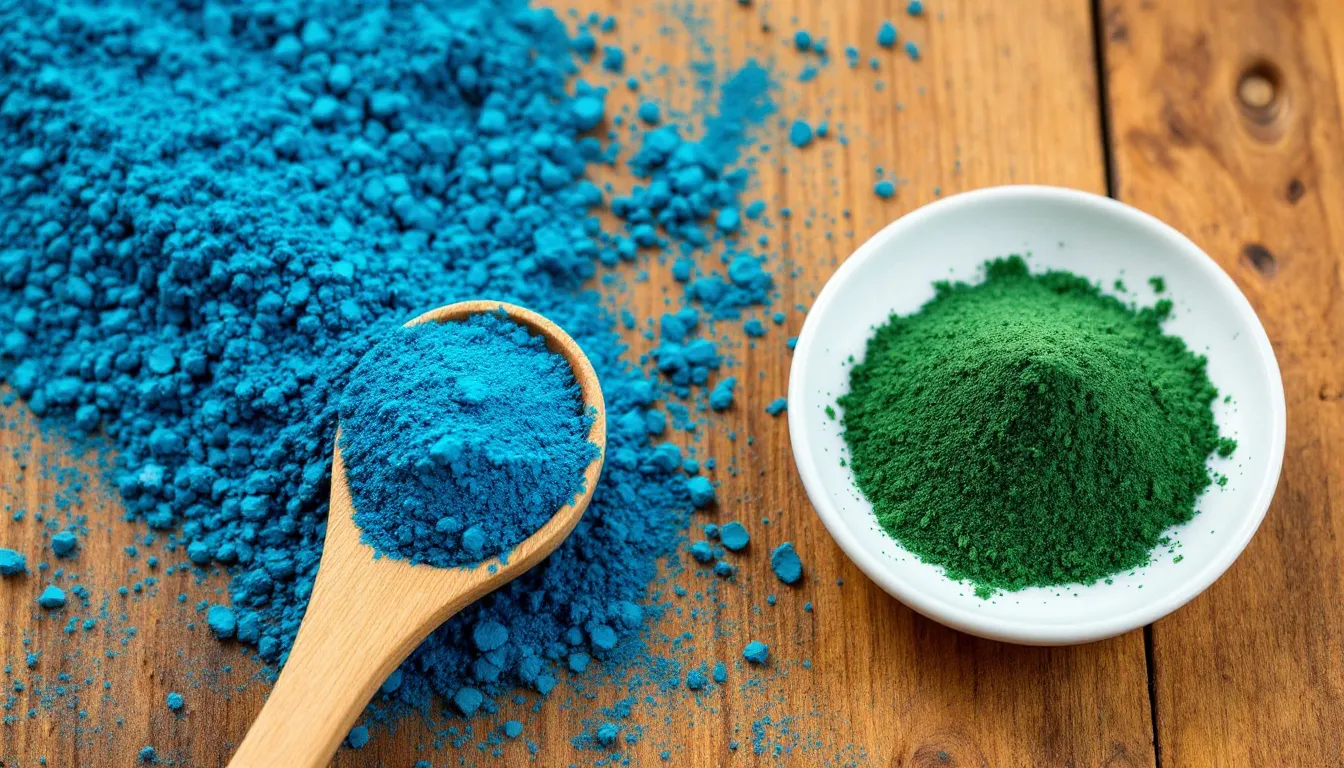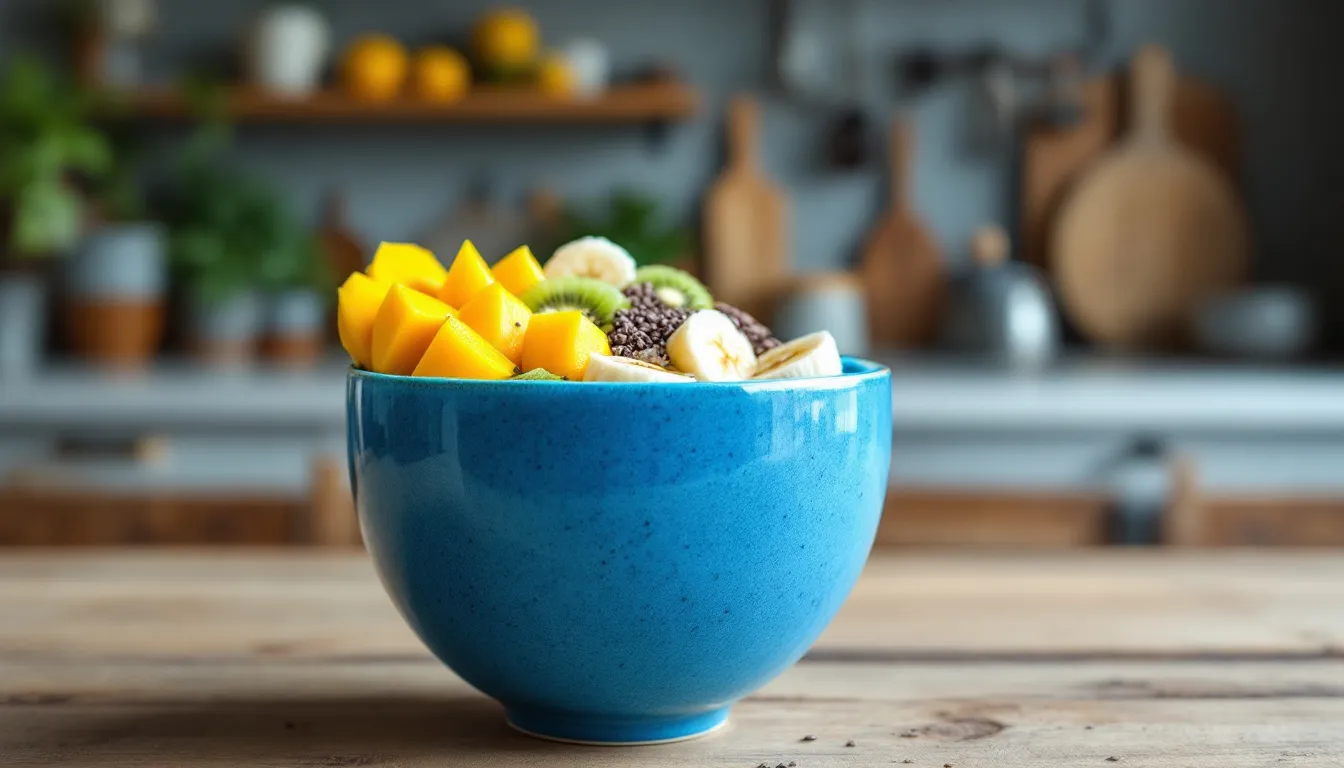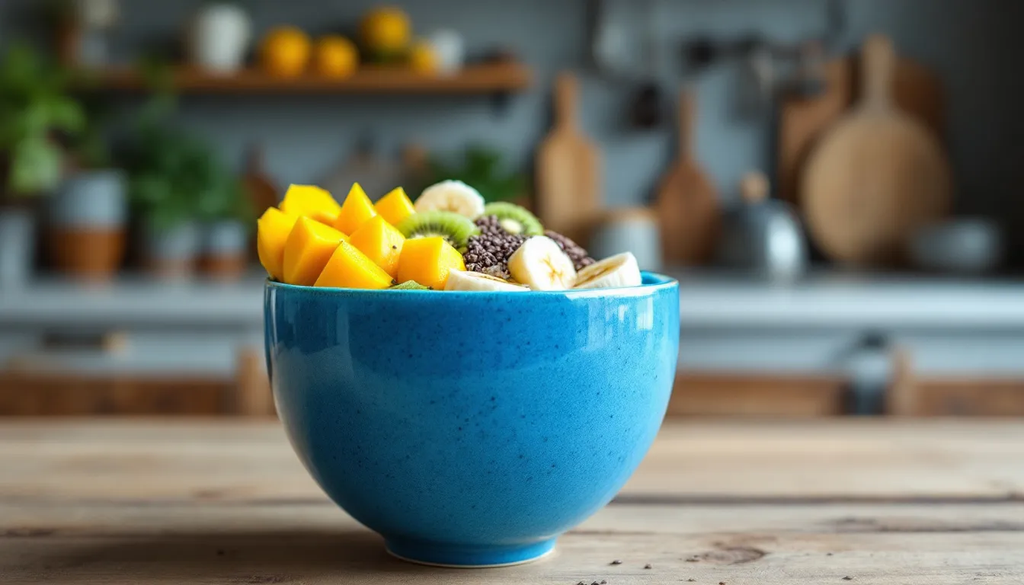Key Takeaways
-
Blue Majik powder is a phycocyanin extract from spirulina, primarily used as a natural blue food coloring rather than a comprehensive superfood
-
While Blue Majik contains antioxidants, whole spirulina provides significantly more protein, vitamins, minerals, and complete nutritional benefits
-
Fresh and frozen spirulina retain more bioactive compounds compared to dried extracts like Blue Majik powder
-
At approximately $47 per 60 grams, Blue Majik is an expensive way to get spirulina’s benefits compared to whole spirulina products
-
For optimal nutrition, consider whole spirulina forms (especially frozen) rather than isolated pigment extracts
What is Blue Majik Powder?
Blue Majik powder has taken social media by storm with its stunning azure hue, but this Instagram-worthy supplement is more complex than its beautiful blue color suggests. Blue majik is a proprietary phycocyanin extract developed by E3Live in 2009, derived from the blue green algae spirulina (arthrospira platensis). Unlike whole spirulina, which contains the complete nutritional profile of this ancient superfood, Blue Majik isolates just one component - the vibrant blue pigment called phycocyanin.
This chemical-free extract contains approximately 30-40% phycocyanin, the photosynthetic protein responsible for spirulina’s distinctive color. The extraction process removes most of the original algae’s nutritional matrix, including protein, B vitamins, minerals, and fiber, leaving behind primarily the concentrated blue pigment.
Available as a fine powder form, Blue Majik typically costs around $47 per 60 grams, making it significantly more expensive per gram than whole spirulina products. The premium pricing reflects both the complex extraction process and the product’s popularity as a natural blue food colorant for creating those picture-perfect smoothie bowls and beautiful smoothies that dominate social media feeds.

While people are drawn to its vibrant appearance and the association with spirulina’s health benefits, it’s important to understand that Blue Majik functions primarily as a coloring agent rather than a comprehensive dietary supplement.
Blue Majik vs. Whole Spirulina: Understanding the Difference
The extraction process that creates Blue Majik fundamentally changes what you’re getting compared to whole spirulina. When manufacturers isolate phycocyanin from spirulina platensis, they remove the vast majority of nutrients that make spirulina a celebrated superfood.
|
Nutrient |
Blue Majik (1g serving) |
Whole Spirulina (1g serving) |
|---|---|---|
|
Protein |
Minimal (trace amounts) |
650-700mg (65-70%) |
|
Iron |
Negligible |
2.8mg (15% DV) |
|
B Vitamins |
Trace levels |
Significant amounts |
|
Magnesium |
Minimal |
19mg |
|
Potassium |
Trace |
136mg |
|
Fiber |
None |
Present |
This comparison reveals why nutrition experts emphasize that spirulina contains a rich source of complete protein and essential nutrients, while blue spirulina extracts provide primarily the isolated pigment. Research suggests that the health benefits associated with spirulina supplementation come from the synergistic effect of its complete nutritional profile, not just individual compounds.
From a cost perspective, if you’re seeking protein, you’d need to consume impractical amounts of Blue Majik to match what you’d get from a single serving of whole spirulina powder. The overall better quality nutrition comes from the intact algae, which has been clinically shown to support various aspects of health when consumed regularly.
The Science Behind Phycocyanin
Phycocyanin is more than just a natural pigment - it’s a protein complex with documented antioxidant properties. This powerful antioxidant has been studied for its potential therapeutic potential, particularly its anti inflammatory effects and ability to inhibit COX-2 enzymes, which may help support healthy joints and relieve physical discomfort.
Current pharmaceutical biotechnology research has examined phycocyanin’s potential to help blood vessels relax and support cardiovascular health. Some studies suggest it may help with blood pressure regulation and have anti cancer properties, though more research is needed to fully understand these mechanisms in humans.
However, there’s a crucial limitation in applying this research to Blue Majik powder: most studies on spirulina’s health benefits, including effects on blood sugar, heart health, and anti-inflammatory properties, have been conducted on whole spirulina rather than isolated phycocyanin extracts. The National Institutes of Health databases show that whole spirulina’s benefits likely come from the complex interaction of its complete nutritional profile.
While phycocyanin does demonstrate antioxidant activity in laboratory settings, taking spirulina in its whole form may provide superior nutritional and therapeutic potential due to the presence of complementary compounds that enhance bioavailability and effectiveness.
Fresh vs. Dried Spirulina: Why Form Matters
The processing method significantly impacts spirulina’s nutritional value and bioactive compounds. Understanding these differences helps explain why frozen spirulina pods represent an optimal choice for those seeking maximum health benefits.
Fresh spirulina maintains higher enzyme activity and bioavailability compared to processed forms. However, fresh spirulina is extremely perishable and rarely available outside specialized facilities due to rapid nutrient degradation.
Dried Spirulina Powder: Conventional spirulina tablets and powdered spirulina undergo heat treatment during drying, which can reduce enzyme activity and damage heat-sensitive vitamins. While still nutritious, this processing diminishes some of the algae’s therapeutic potential.
Frozen spirulina represents the best of both worlds - it preserves the delicate nutritional compounds through flash-freezing while providing practical convenience. This method maintains:
-
Higher enzyme activity than dried forms
-
Intact vitamin profiles
-
Better preservation of anti-inflammatory compounds
-
Enhanced bioavailability of nutrients
The freeze-preservation process protects the algae from the oxidation and nutrient loss that occurs during traditional drying methods. For those serious about spirulina’s potential health benefits - whether for energy levels, heart disease prevention, or overall nutritional support - frozen forms offer superior quality compared to both dried powders and extracted pigments like Blue Majik.
Blue Majik as Natural Food Coloring
Blue Majik’s primary strength lies in its role as a natural blue food colorant, offering a clean alternative to artificial dyes like Blue #1 and Blue #2. This application makes perfect sense given that food coloring is essentially what Blue Majik provides.
The pigment remains relatively stable across different pH levels and temperatures, though excessive heat can cause color degradation. It works exceptionally well in:
-
Smoothie bowls and protein shakes
-
Plant-based ice cream and frozen desserts
-
Chia puddings and overnight oats
-
Raw vegan desserts and energy bites
-
Cold beverages and plant-based milks
From a cost perspective, Blue Majik is an expensive option for food coloring compared to alternatives, but it offers the marketing appeal of being derived from a recognized superfood. The beautiful blue color creates visually striking foods that photograph well for social media, driving much of its popularity.
For restaurants and food manufacturers seeking certified organic, natural coloring options, Blue Majik provides an attractive solution despite its premium pricing. However, consumers should understand they’re paying primarily for aesthetic appeal rather than significant nutritional value.
How to Use Blue Majik Powder
The recommended serving size for blue majik powder is typically 1 teaspoon (1 gram) per day, though this amount provides minimal nutritional impact compared to equivalent servings of whole spirulina. The powder has a mild, slightly earthy flavor that’s much less intense than whole spirulina, making it easier to incorporate into recipes.
Best Mixing Practices:
-
Blend with liquids first to prevent clumping
-
Add to cold or room temperature ingredients
-
Avoid excessive heat to preserve color and nutrients
-
Mix thoroughly to achieve even color distribution
Popular Recipe Applications:
-
Blue smoothie bowls with tropical fruits
-
Protein shakes for post-workout nutrition
-
Overnight oats for a colorful breakfast
-
Raw desserts and no-bake treats
-
Cold-pressed juices and wellness shots

Temperature considerations are important - high heat can degrade both the color and any remaining nutrients. For pregnant women or those with specific health conditions, consulting healthcare providers before adding any new supplement is advisable.
Making an Informed Choice: Blue Majik or Whole Spirulina?
The decision between Blue Majik and whole spirulina should align with your primary goals and budget considerations.
When Blue Majik Makes Sense:
-
Primary goal is natural food coloring
-
Creating visually appealing recipes for social media
-
Specific aesthetic requirements for food products
When Whole Spirulina is Better: See what science and your gut really say about spirulina and gut health.
-
Seeking comprehensive nutritional benefits
-
Looking for protein supplementation
-
Want maximum value for health investment
-
Aiming to support energy levels, heart health, or overall wellness
Cost-Effectiveness Analysis: At $47 per 60 grams, Blue Majik costs significantly more per gram than Fresh Frozen Spirulina Pods.
For those genuinely interested in spirulina’s potential health benefits - from supporting healthy joints to cardiovascular wellness - frozen spirulina pods offer optimal nutrition preservation while maintaining convenience. This form provides the complete nutritional profile that has made spirulina valuable to cultures from the ancient aztecs to modern wellness enthusiasts.
Safety and Considerations
Blue Majik powder holds generally recognized as safe (GRAS) status and is considered non-toxic in standard dietary quantities. However, several considerations warrant attention:
Potential Side Effects:
-
Mild digestive upset in sensitive individuals
-
Possible allergic reactions in those sensitive to algae
-
Physical discomfort if consumed in excessive amounts
To learn more about the health benefits of algae, visit our dedicated page.
Important Contraindications:
-
Individuals with phenylketonuria (PKU) should avoid due to phenylalanine content
-
Those with autoimmune conditions should consult healthcare providers
-
People taking blood-thinning medications should discuss spirulina use with doctors
Quality Considerations: The highest quality Blue Majik products come from certified organic sources with third-party testing for:
-
Heavy metal contamination
-
Microbial purity
-
Toxin screening
-
Potency verification
Special Populations: Pregnant women should consult healthcare providers before taking spirulina in any form. While spirulina is generally safe, individual circumstances may warrant specific guidance.
Poor-quality spirulina products from unvetted sources can pose risks including contamination with harmful bacteria or toxins. Always choose products from reputable manufacturers who test their algae for purity and provide transparent sourcing information.
Anyone experiencing adverse reactions should discontinue use and consult healthcare professionals. While rare, some individuals may have allergic rhinitis or other sensitivities to algae-derived products.
FAQ
Is Blue Majik powder worth the high price compared to regular spirulina?
For nutritional value, no. Blue Majik costs roughly 3-4 times more than whole spirulina while providing minimal protein, vitamins, or minerals. If your goal is health benefits, whole spirulina offers significantly better value. Blue Majik is primarily worth the cost if you specifically need natural blue food coloring and want the marketing appeal of spirulina association.
Can I get the same blue color using whole spirulina powder?
No, whole spirulina powder appears green due to its high chlorophyll content combined with other pigments. The blue color specifically comes from isolated phycocyanin, which requires extraction processes to separate from the other compounds. Whole spirulina will give foods a green tint rather than the vibrant blue that Blue Majik provides.
What’s the difference between Blue Majik and other phycocyanin extracts on the market?
Blue Majik is a specific branded product by E3Live, but many companies now offer similar phycocyanin extracts under names like “blue spirulina” or “spirulina blue.” The main differences lie in purity levels (phycocyanin concentration), extraction methods, source quality, and price. Some products may contain 30-40% phycocyanin while others might be lower. Always check certificates of analysis for actual phycocyanin content.
How long does Blue Majik powder stay fresh and maintain its color?
When stored properly in airtight, opaque containers away from light and heat, Blue Majik powder can maintain quality for up to two years. However, the vibrant blue color is sensitive to light, heat, and moisture, so refrigerated storage is recommended. The color may fade over time even with proper storage, and exposure to high temperatures during cooking can cause immediate color degradation.
Are there any studies comparing the health benefits of Blue Majik versus whole spirulina?
Most research on spirulina’s health benefits has been conducted on whole spirulina rather than isolated phycocyanin extracts like Blue Majik. While phycocyanin shows antioxidant properties in laboratory studies, the comprehensive health benefits attributed to spirulina - including effects on cholesterol levels, body weight, diabetes management, and heart disease prevention - come from studies using complete spirulina products. More research is needed to determine if isolated phycocyanin provides the same therapeutic benefits as whole spirulina.

